20 de June de 2023
Hockey resistance training, strength and speed
Features a Hockey Player Must Have
Ice hockey requires high levels of strength, acceleration, speed, power, endurance, agility, and balance (Nightingale, 2014). Greater explosive strength and acceleration can make a player win the puck and have better offensive and defensive performance. Similarly, better performance indicators (KPIs) increase the athlete’s chances of success in their tasks, and by extension, the team’s chances of winning.
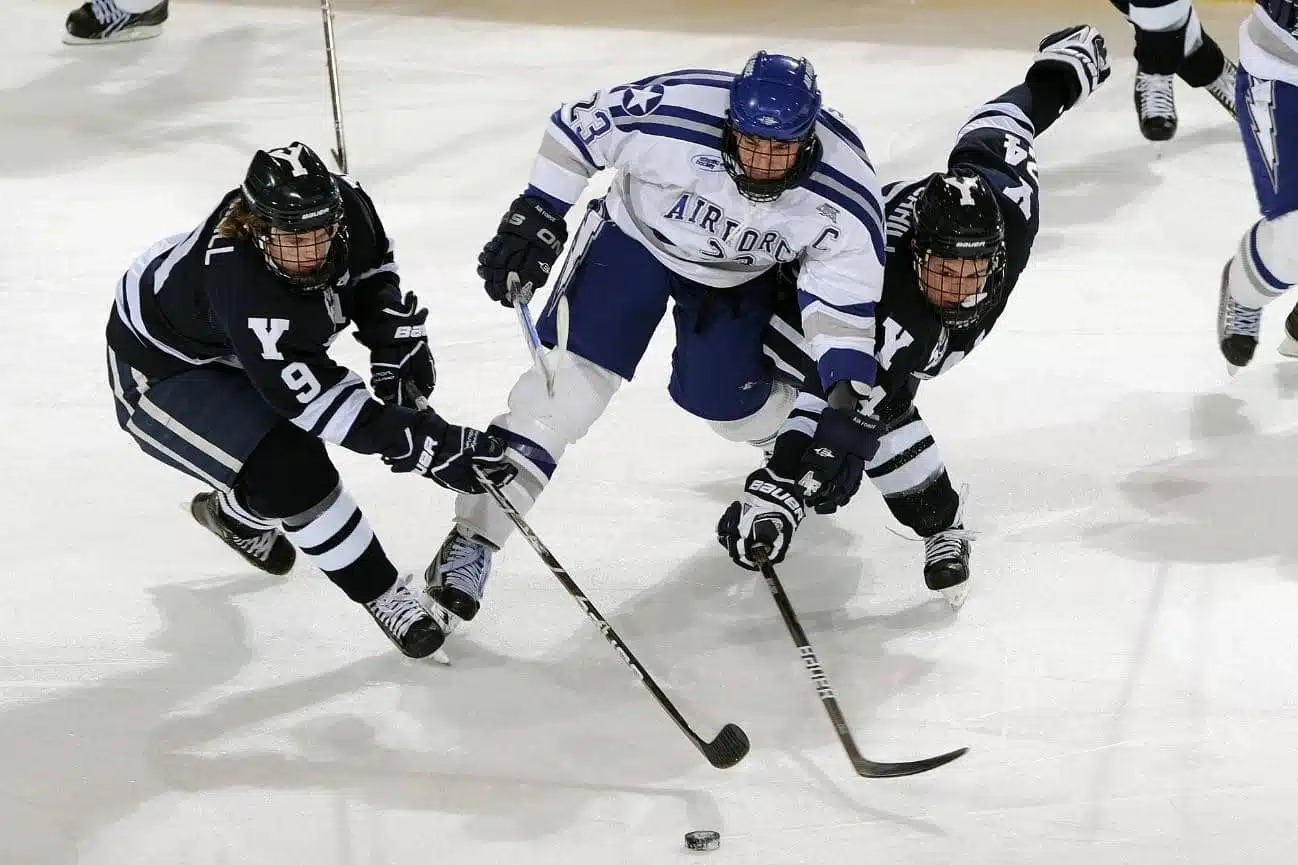
Hockey presents several unique biomechanical considerations compared to other team sports. In general, forward skating involves alternating high-speed diagonal pushes that involve hip extension, abduction, and external rotation, along with knee extension and ankle plantar flexion (Buckeridge et al., 2015). This would be one of the key performance indicators, as players with higher hip and knee extension speeds in the propulsion phase are the fastest players, and a faster player will reach the puck first, get past a defender, or catch up to an attacker (Upjohn et al., 2008).
The mechanics of movement in hockey involve accelerating and stopping with a slightly forward trunk lean, whether starting from a standstill or while already in motion (Neeld, 2018). Directional changes occur constantly based on our role on the ice and the position of the puck. In addition to acceleration and speed in movement, there are many other patterns associated with hockey, such as significant trunk rotation ending in puck handling, whether for a pass or a shot on goal. All of this requires athletes to prepare in all planes of movement through hockey-specific strength training to excel in speed, power, and strength tests, as elite players outperform their non-elite counterparts in these qualities (Peterson et al., 2015).
Resistance Training for Hockey is Necessary to Improve These Performance Tests
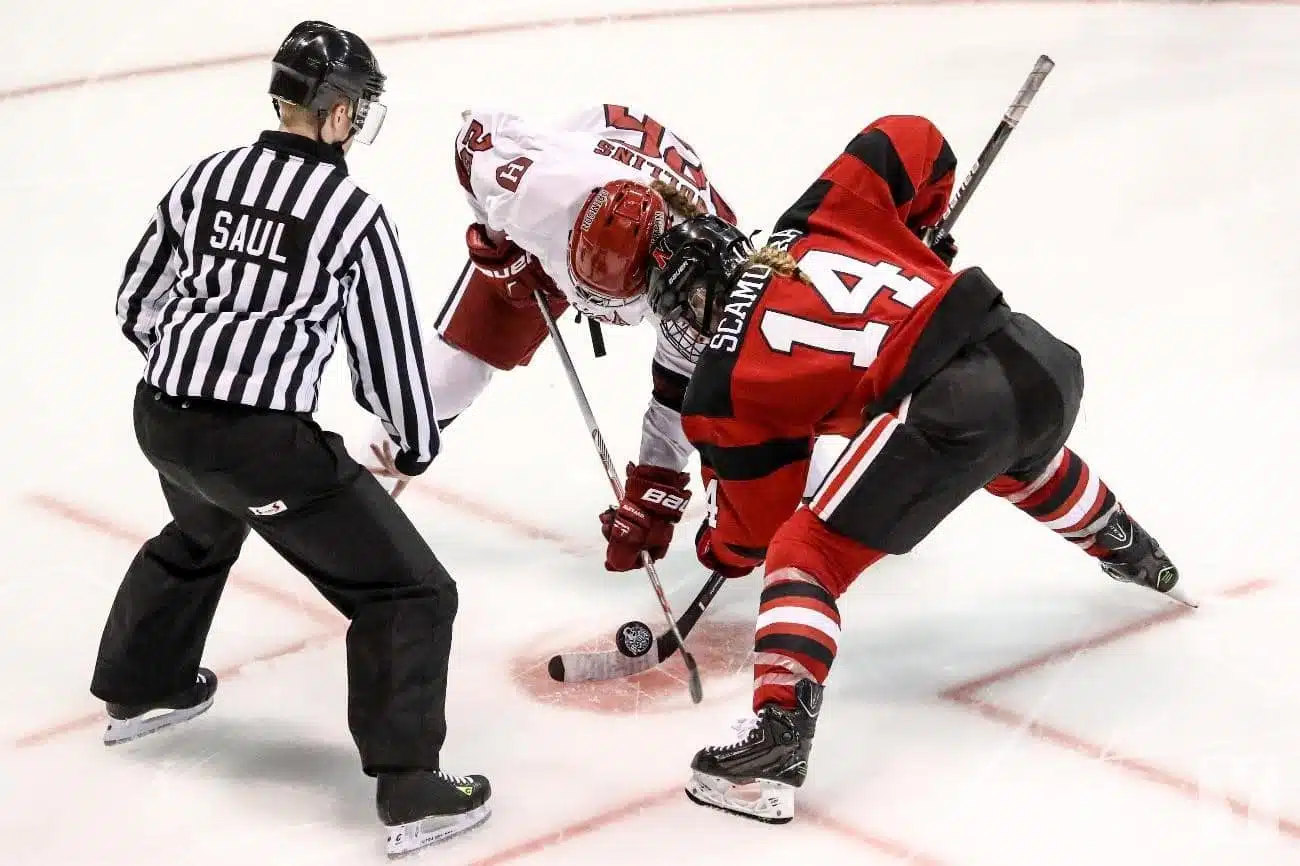
Author Kevin Neeld, in his article ‘Preparing for the Demands of Professional Hockey,’ establishes a set of tests to profile the physical capacity of an elite ice hockey player (Neeld, 2018). Within these tests, there are some such as anthropometric measurements and movement capacity that determine our potential and risk of injury, respectively. The rest of the tests focus on speed, power, strength, and conditioning, highlighting the importance of strength training for hockey to achieve maximum athletic performance.
Speed tests are the classic ones that measure the time it takes to move from one side to another, whether in a linear fashion or with abrupt changes between acceleration and deceleration. Strength training for hockey should aim to improve results in these tests, as we have seen in the previous section that they differentiate between elite and non-elite hockey players.
In terms of power, tests measure this quality in both the upper and lower body, as the use of the stick in shooting and puck control requires a high level of power that starts from the skates and ends in the hands, which transfer the speed to the stick. The rotational medicine ball throw is the test that measures upper body power. This test provides unique information about the generation of low-load, high-speed power in a pattern similar to that used in shooting in hockey.
[banner_device_1]
Vertical jump measures the linear power of the lower body, as leg power is responsible for acceleration and deceleration in every action. In addition to these tests, lateral jumps should be included because hockey is not a linear movement like long-distance endurance races where we always run forward. Strength training for hockey should incorporate forward, sideways, and diagonal movement exercises, covering all planes of movement that occur in a hockey game. Furthermore, lateral jumps also provide information about single-leg power, allowing us to see if there are differences between one limb and the other.
As for strength tests, the author proposes three exercises that measure lower and upper body strength to provide a guide for maximum and submaximal strength that the player can apply in these exercises. One reason for evaluating pushing and pulling strength in the upper body is to assess potential imbalances between these patterns. If our pushing strength is significantly greater than our pulling strength, our shoulders may be at a higher risk of injury. That is why, even though upper body pulling may not be key in this sport, strength training for hockey should take this aspect into account to prevent and address injuries that often occur when the pushing pattern is overused and the pulling pattern is neglected.
Maximal strength will then be transferred to specific hockey movements. Physical conditioning should also be measured, as hockey is a sport with a high component of repeated sprints. Players continuously accelerate and decelerate in attacking and defending transitions, requiring a good level of endurance.
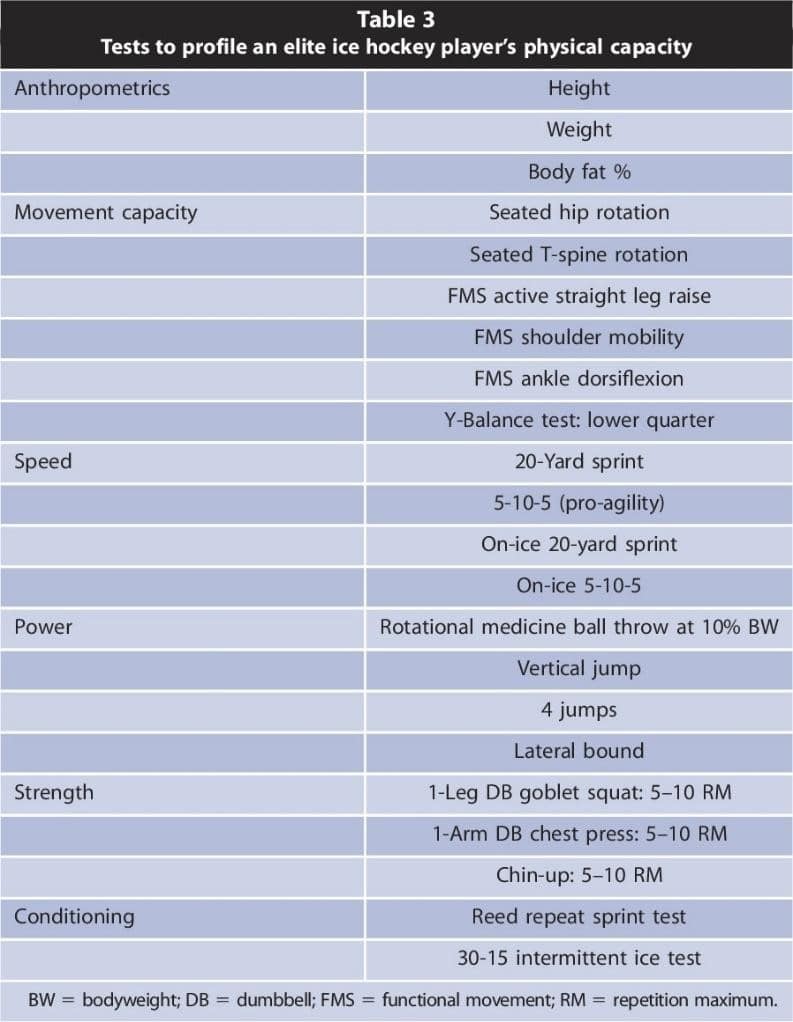
How to Conduct Resistance Training for Hockey?
Every sport and every coach has different models of periodization, with linear, undulating, and block being the three most commonly used . Depending on the selection of one or another, the athlete will carry out strength training with higher load and lower speed, or vice versa, lower load and higher speed. The goal of strength training for hockey is to reach the games and key moments of the season with the maximum peak of specific strength in the sport-specific movements. In hockey, we have already seen the need to accelerate quickly in all directions, transfer force to the stick when striking the puck, and perform compensatory pulling work to prevent shoulder problems and pain.
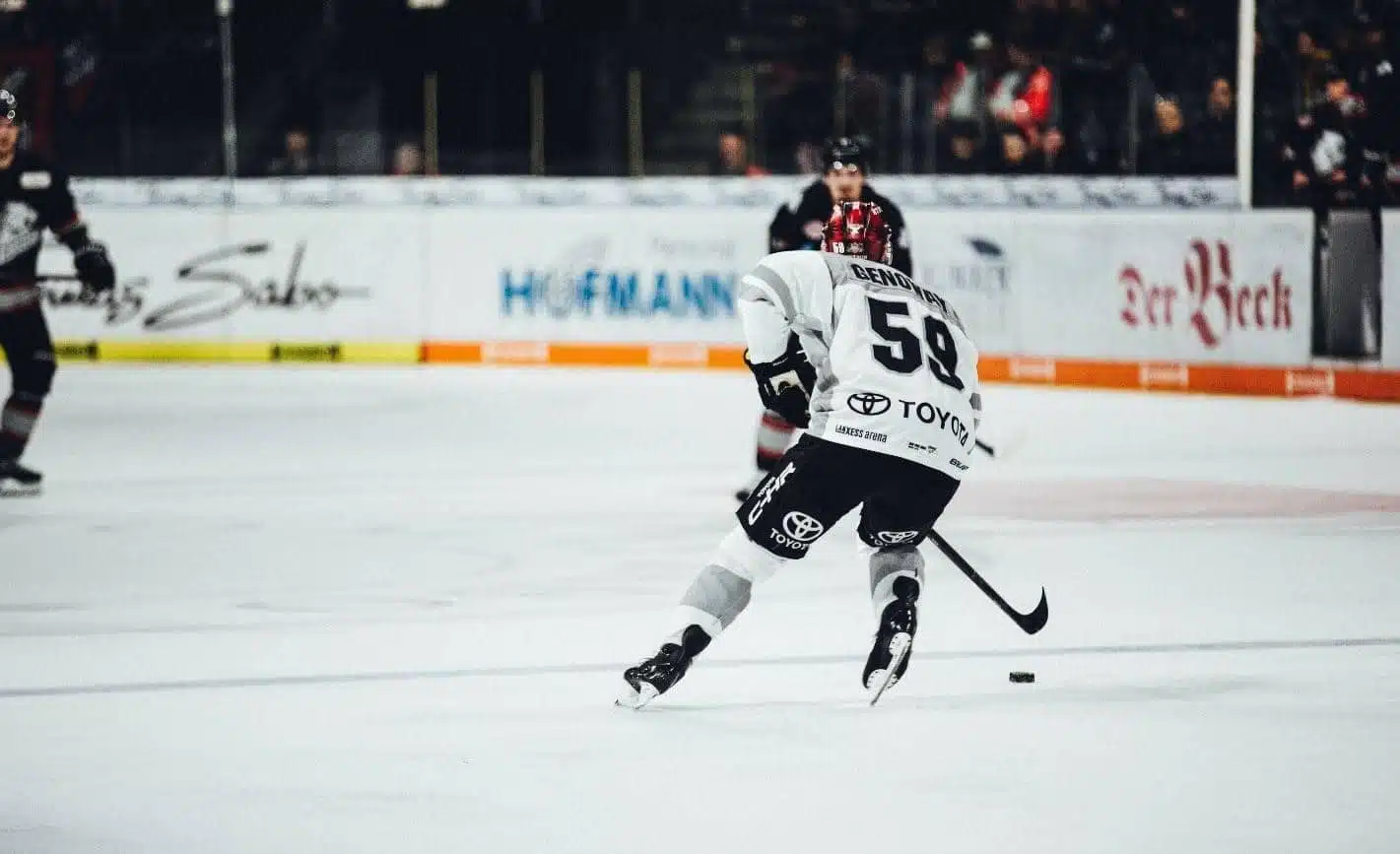
Knowing this, we only need to see which exercises best fit those objectives and fit them into the puzzle. A deep squat with heavy weight will improve our maximum strength when extending the hip and knee, a key indicator as we mentioned at the beginning of the article that distinguishes elite players from non-elite ones. However, the important thing is not to lift 200 kilos in the squat, but to apply that force in the shortest possible time, which is achieved with exercises with less weight and much greater acceleration.
During the preseason, general strength exercises such as hip thrusts are usually introduced, and in moments of specific strength, that general exercise is replaced by others that are more similar to the sport, such as sled pushes with light load. That is how strength training for hockey is periodized. Now we only need to find out which are the best exercises that we can use in this sport.
Heavy Load & Low Velocity Resistance Exercises for Hockey Movements
Strength training for hockey is based on improving maximum strength to then be able to apply greater accelerations, decelerations, and changes of direction. Maximum strength exercises are the classic ones that you are probably already familiar with: squats, deadlifts, and hip thrusts. These three exercises, as well as their variations, form the foundation of maximum strength, which will later be transferred to hockey using other exercises with lower load and higher speed (Ebben et al., 2004).
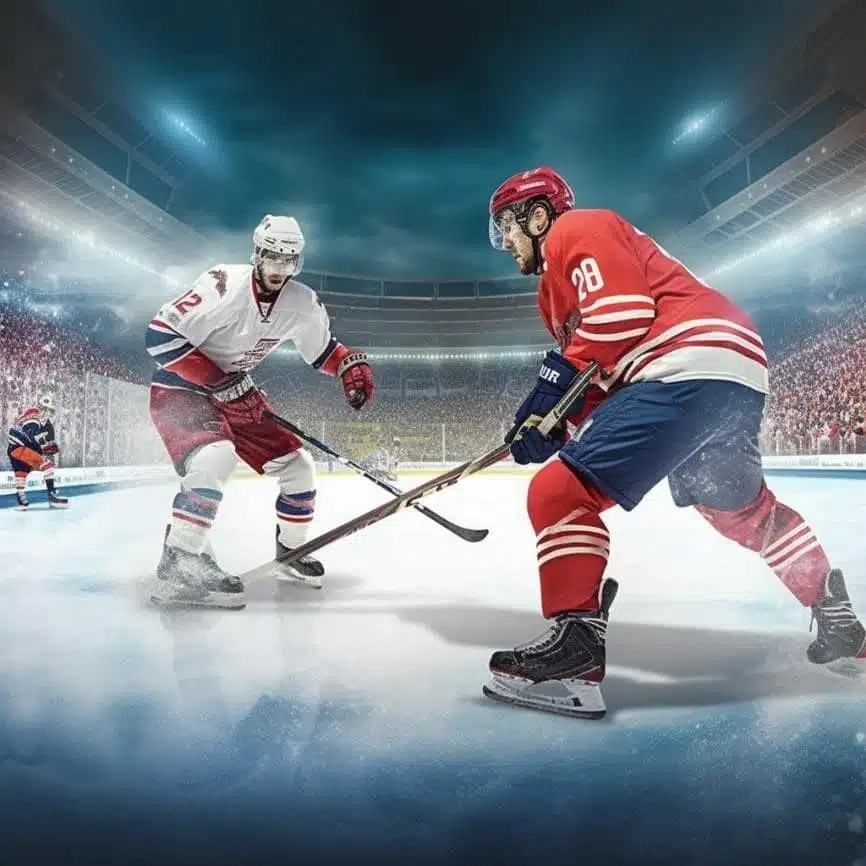
With these movements, we target the left side of the Force-Velocity Curve, which is the zone where we can move a lot of load, but the speed at which we do it is very low. Focusing too much on this zone, just as focusing on the zone of maximum speed and lower load, is a mistake. Sporting success lies in finding the balance in all zones of the force-velocity curve, as this will result in an athlete who applies a lot of force in very little time, which becomes evident through greater acceleration and more successful changes of direction.
Olympic movements are located in the middle of the force-velocity curve and are vital for any sport that requires accelerations and decelerations (Antunes et al., 2022). Cleans and snatches, as well as their variations, will make our strength training for hockey result in faster players who achieve higher speed in less time. Lunges are also halfway between maximum strength and maximum speed and are essential in sports that require movement in all directions and constant changes of direction.
Strength training for hockey should include lunges and single-leg training, as all actions are performed with one leg, not two. In sports like basketball, there are actions like jumps that are done with both legs, but in hockey, acceleration and changes of direction are done with one leg, so we must train with that focus. Some examples of exercises are lateral and diagonal lunges, Lateral & Diagonal Step-Ups, Dumbell Skier Lunges, as well as linear lunges and single-leg work such as Bulgarian split squats or Skater Squats. These exercises are essential and should not be overlooked.
The right side of the force-velocity curve is dedicated to work done at high speed with low loads. It is in this part where the knowledge and art of the coach come into play to select the best exercises that transfer maximum strength to hockey, thus achieving the ultimate goal: to move faster in less time.
Light Load & High Velocity Resistance Exercises for Hockey Movements
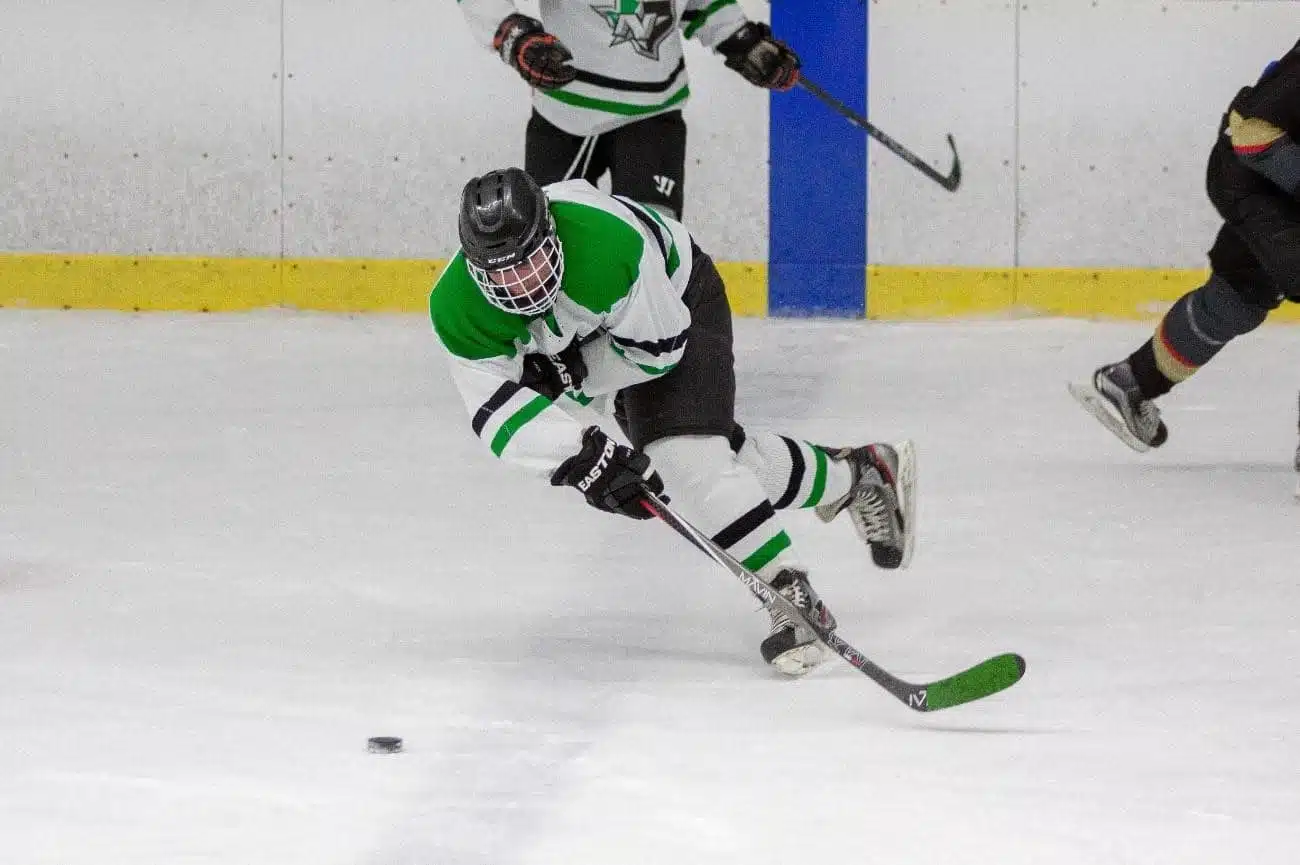
Sled Pull Movements
One of the most specific ways to train strength and speed for hockey is to use resisted sleds, as is done in other sports like American football and any sport that requires accelerations and changes of direction (NSCA, 2019). Different research studies have shown that sled loads of up to 40% of the player’s body weight can be ideal for improving acceleration (NSCA, 2019). If the goal is to increase maximum speed, lighter loads ranging from 10% to 20% of the player’s body weight are recommended (Serrano & Serrano, 2020).
This is general data, as the sled load will depend on various factors such as the athlete’s strength level and the surface on which it is used, due to different friction. The most important factor to consider is that the running mechanics should not be altered when training off the ice or skating mechanics when training on the ice rink (Cahill et al., 2019). The choice of heavier or lighter loads will also depend on the phase of the season, with heavier sled weights being a better option in the preseason and lighter weights during key moments of the season.
Plyometrics: The Perfect Training for Accelerating and Changing Direction
Plyometrics involves applying reactive energy after a support phase to take advantage of the accumulated energy from the previous stride. This is achieved through the rapid stretch-shortening cycle and can be easily trained. Plyometric training is linked to improved sprint and change of direction performance in hockey players (Dæhlin et al., 2017; Singh et al., 2018). There are countless possible plyometric exercises, with the key factor being that the next jump should occur in the shortest possible time after the previous one. One of the classic exercises in hockey, which is named after the sport itself, is the skater jumps, which involve lateral lunges with jumps from side to side.
Similarly, we should perform these types of jumps and plyometric exercises diagonally and in a linear fashion, covering the three directions in which we can move in hockey. If we want to increase intensity, instead of performing jumps without a drop, we can incorporate boxes and hurdles that require us to jump higher and land from an elevated surface, increasing the impact and reactive force that we need to generate.
Resistance Training for Hockey: Rotations
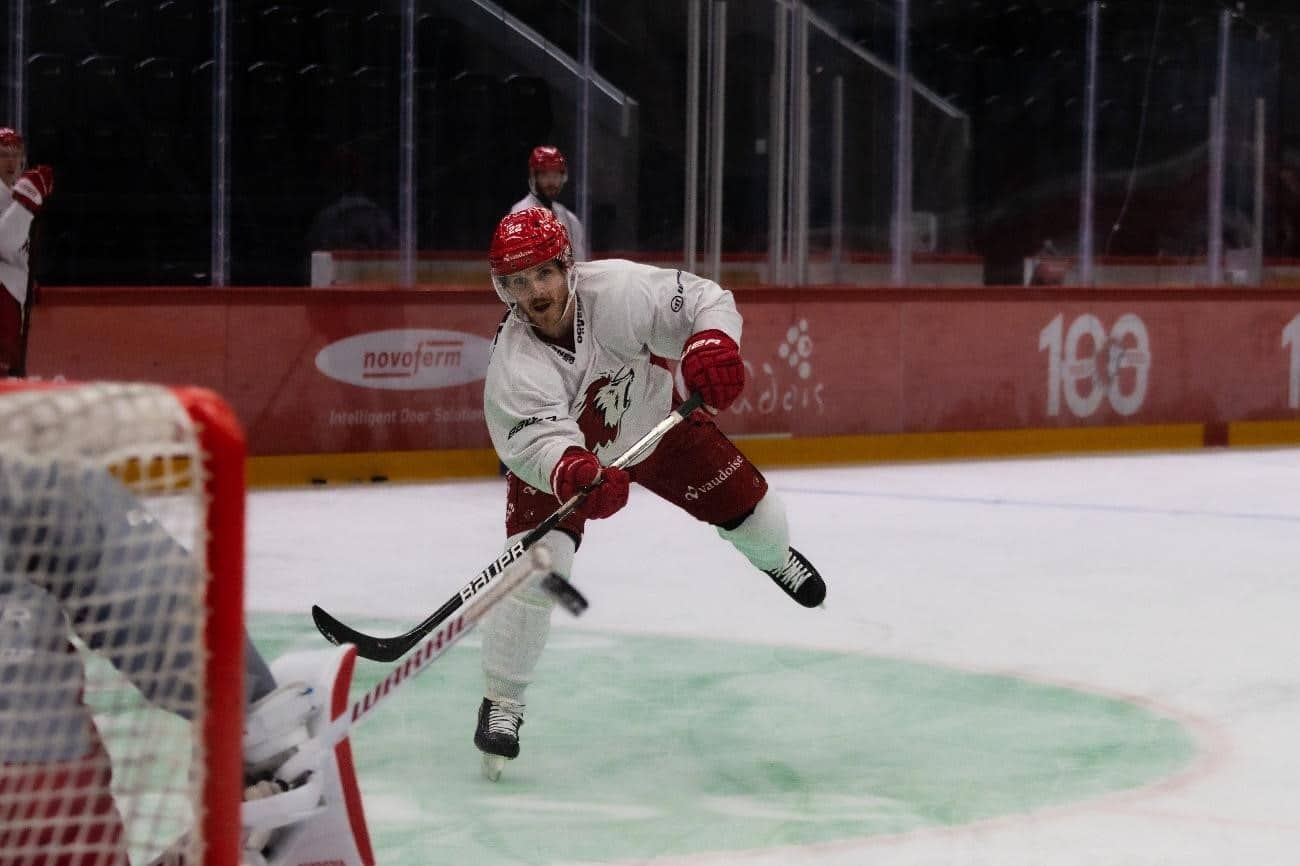
Rotations are often overlooked by many coaches of recreational athletes, as they may not be aware of the performance benefits of incorporating rotational training into strength sessions. Sports are filled with rotational movements, whether it’s changing direction during movement or using an implement like a hockey stick to strike an object, in this case, the puck. Increased rotational acceleration and improved mobility in the structures responsible for rotation are associated with faster puck speeds (Robbins et al., 2021). Therefore, the puck strike, similar to baseball batting or golf swings, has a significant rotational component that determines the speed at which the struck object is propelled.
In strength training for hockey, we should incorporate both controlled and explosive rotational exercises. The “Pallof Press” is a foundational exercise to start with rotation, as it is an isometric exercise that prepares the muscles for movement; it serves as anti-rotation before rotation. The next step is exercises like the “cable Standing Rotational Lif” or the “explosive Landmine Press with Twis,” among many others that involve gripping a load and performing a rotation from the feet to the arms.
Medicine balls are the primary equipment used for explosive rotational exercises. The “standing med ball rotational throw” is a classic rotational exercise where we stand sideways to a wall and throw the medicine ball against it. There are many other exercises we can perform, such as the figure 8, where we first trace a figure 8 pattern with the medicine ball and then throw it against the wall. All throwing exercises involving rotation, whether performed standing, lying down, or in any other position, can be included in this category.
By performing rotations with an external load and executing the exercise with high velocity, we produce adaptations that will be manifested in a faster puck heading towards the goal, a puck that evades interception from an opponent because it’s moving rapidly towards a teammate, or gaining possession of the puck by moving the stick more swiftly than the opponent.
Complementary Resistance Training for Hockey: Pulls & Grips
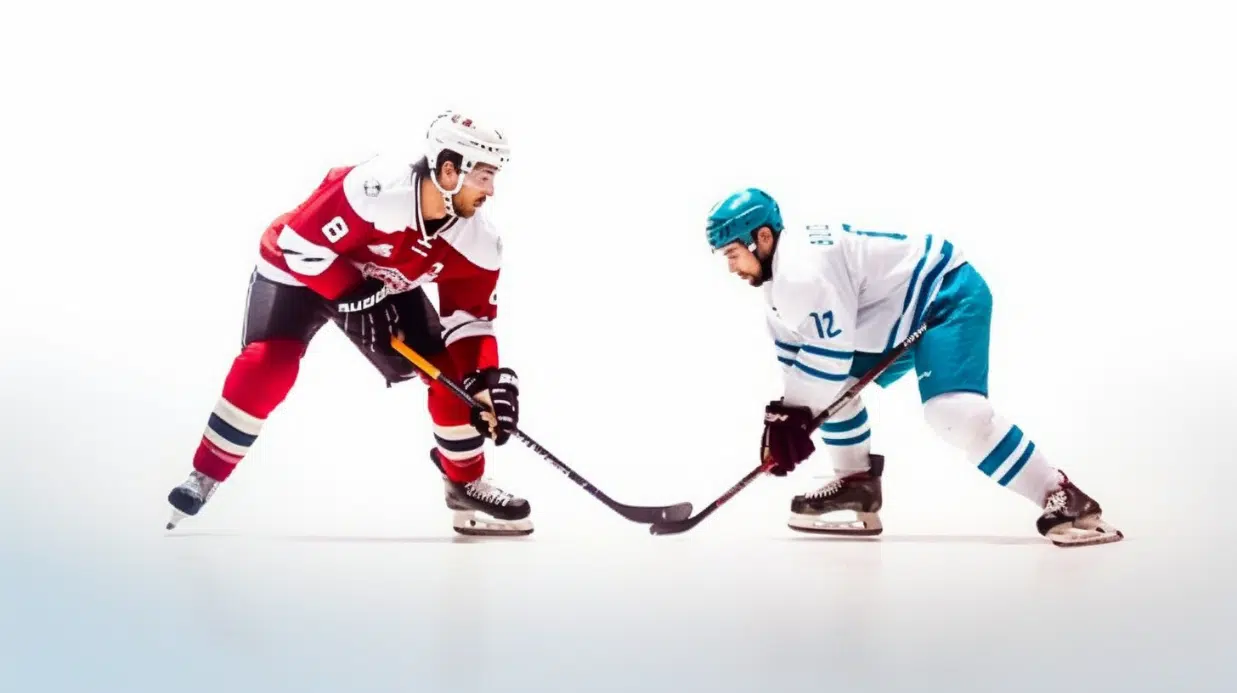
It’s important to prioritize injury prevention in training, as avoiding injuries allows us to train consistently. While complementary work may not directly impact performance significantly, it does help prevent pain and injuries that can disrupt training and competition. Although hockey doesn’t involve pulling an opponent like in judo or rugby tackles, it is necessary to train pulling movements to compensate for the excessive shoulder workload from stick handling. Additionally, working on grip strength can help better transfer forces to the stick and prevent forearm fatigue after prolonged gripping.
Pulling Movements
Pulling movements can be categorized into vertical pulls and horizontal pulls. Vertical pulls involve pulling a load from bottom to top, such as pull-ups or cable pulldowns. Horizontal pulls involve pulling a load from front to back, as seen in rowing exercises. In strength training for hockey, both vertical and horizontal pulling movements should be included to prevent and alleviate shoulder tension and pain. If your hockey player has significantly more strength in the bench press than in rows or pull-ups, it’s highly likely they have had or currently have shoulder issues.
Grip Strength
Hockey players constantly engage the flexor muscles of their hands while on the ice. To prevent fatigue in the forearm flexor muscles and improve grip strength, specific exercises targeting these muscles should be incorporated. While these exercises don’t require heavy loads during the session, as there are more important tasks, it’s possible to add an exercise at the end of the session or include one every other session. Grip strength can be trained using specific equipment like gripping discs or dumbbells, performing wrist flexion exercises, and indirectly through all pulling exercises or by holding and transporting weights, as seen in the farmer’s walk exercise.
Sample Off-Season Resistance Training for Hockey
Author Kevin Neeld, in his article “Preparing for the Demands of Professional Hockey,” proposes an example of a five-phase strength and conditioning training program for hockey preseason, spanning a total of 14 weeks (Neeld, 2018). The following table (Table 4) provides a summary of the desired adaptations in each of the five phases, as well as the variables utilized in each phase.
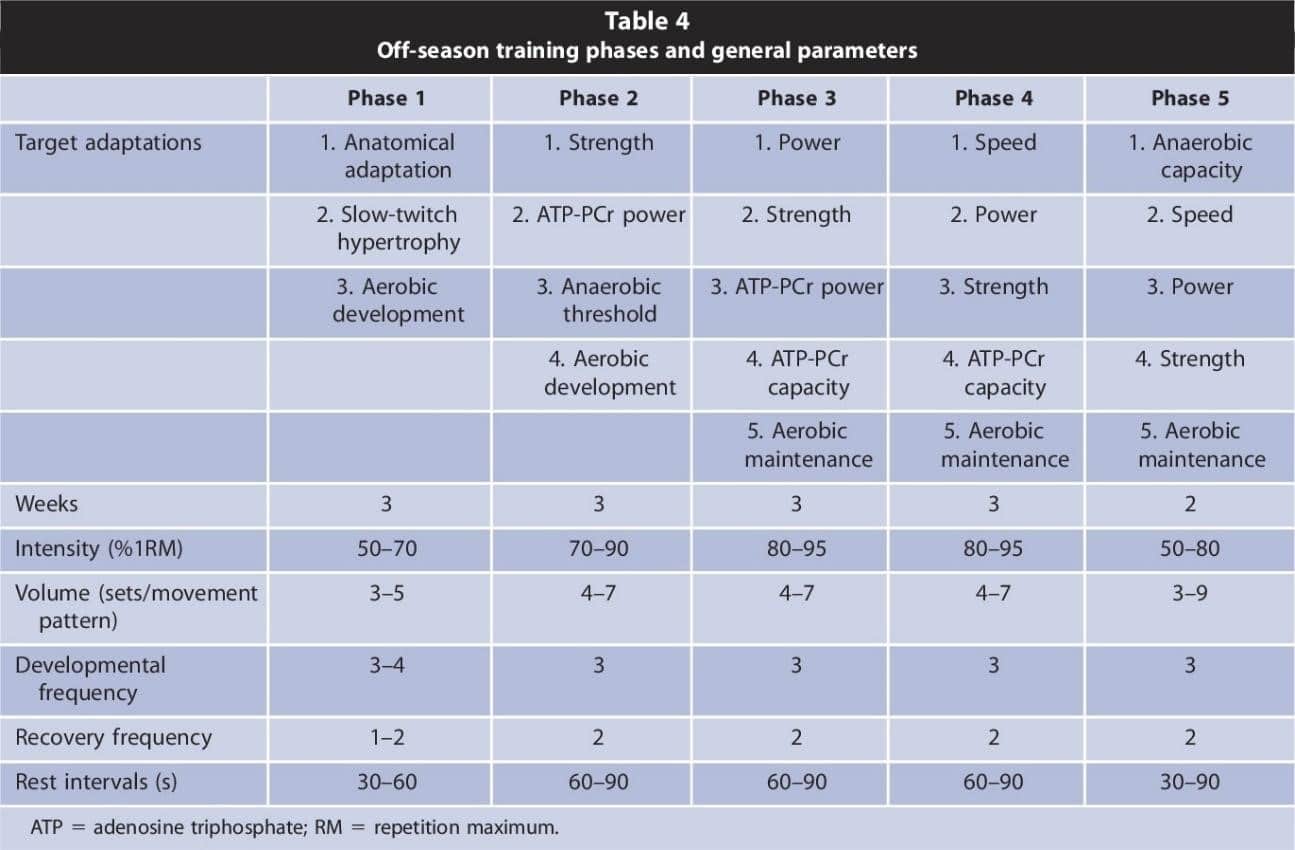
Each day of each phase utilizes different methods, encompassing all the physical qualities needed by a hockey player. If we look at Day 1 of Phase 1, we can see how the training is focused on lower body hypertrophy work along with high-intensity aerobic training. Each day and each phase have different objectives and therefore employ different methods.
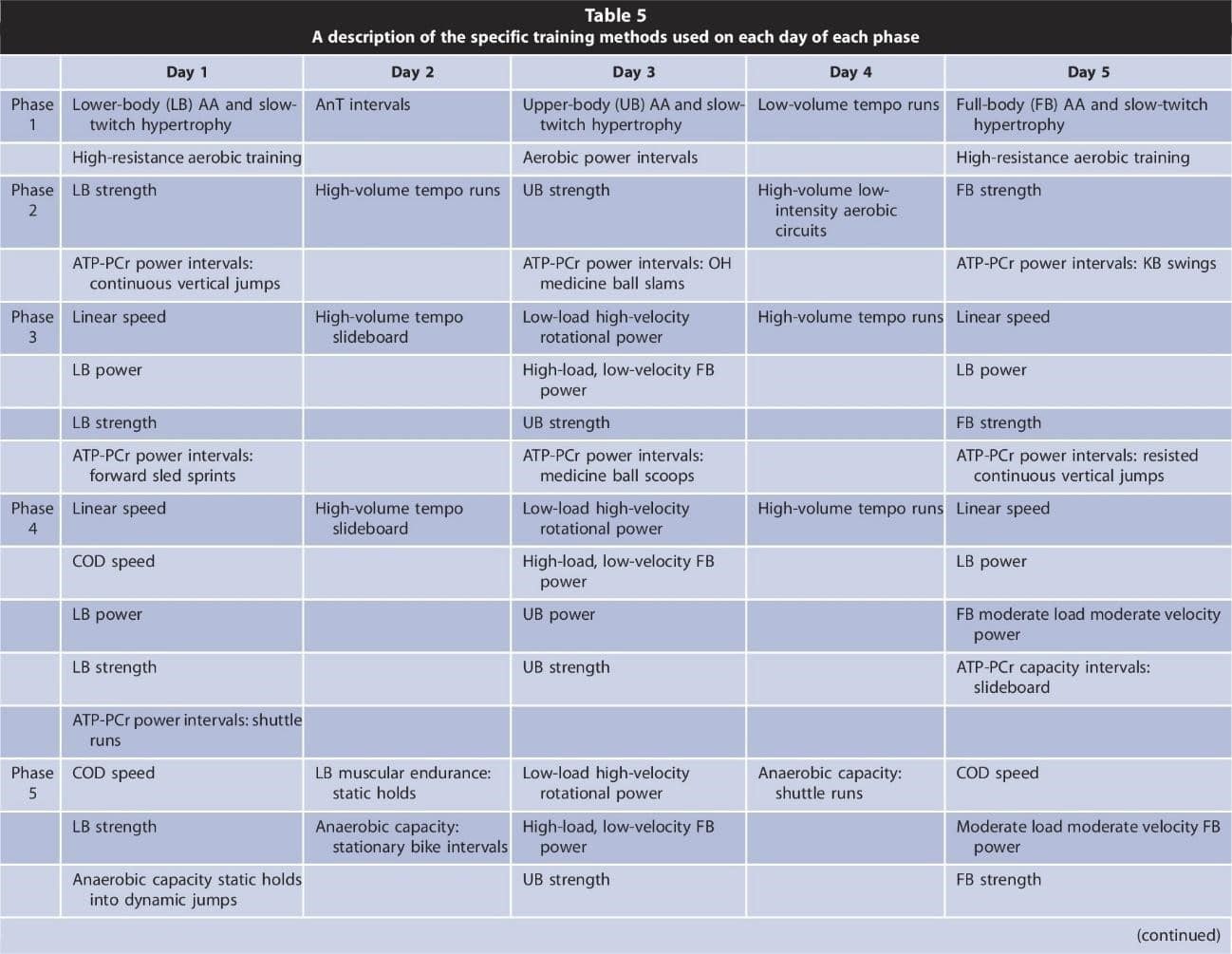
In the following table (Table 6), the author provides examples of exercises performed in each of the phases. Some of the exercises have been discussed throughout the article, and others such as “slideboard hamstring curll” or “DB farmer’s walk” are options for working on strength in hockey players. You can find these and many other exercises in the list below, and if you’re unsure about any of the exercises, simply copy them into a Google or YouTube search to see their execution.
In the exercise list, you can observe a focus on improving lower body strength to accelerate, decelerate, and change direction faster. There are also pushing exercises and core work for stick-related tasks (passes, shots, and puck control), and pulling exercises are included to prevent and alleviate shoulder discomfort.
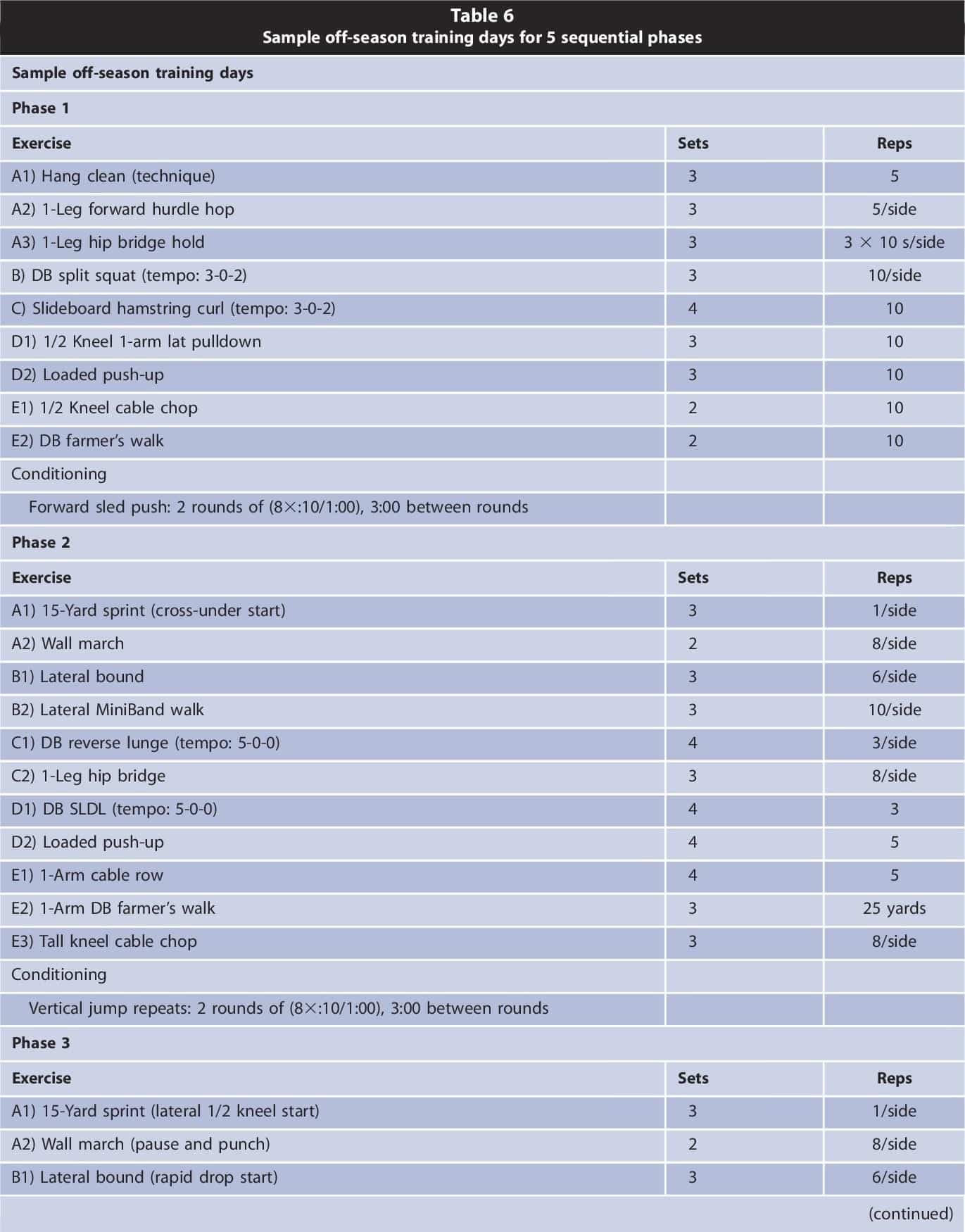
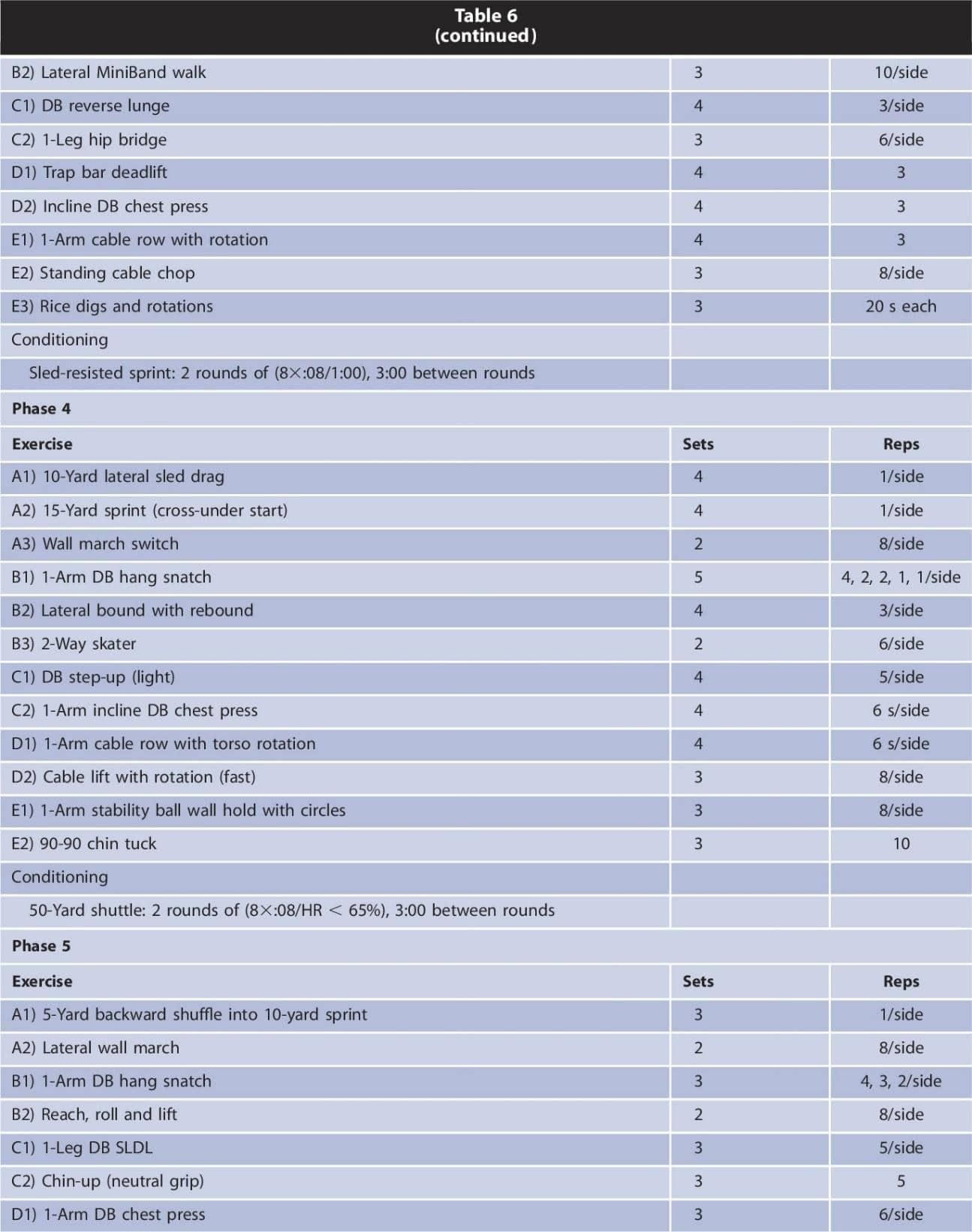
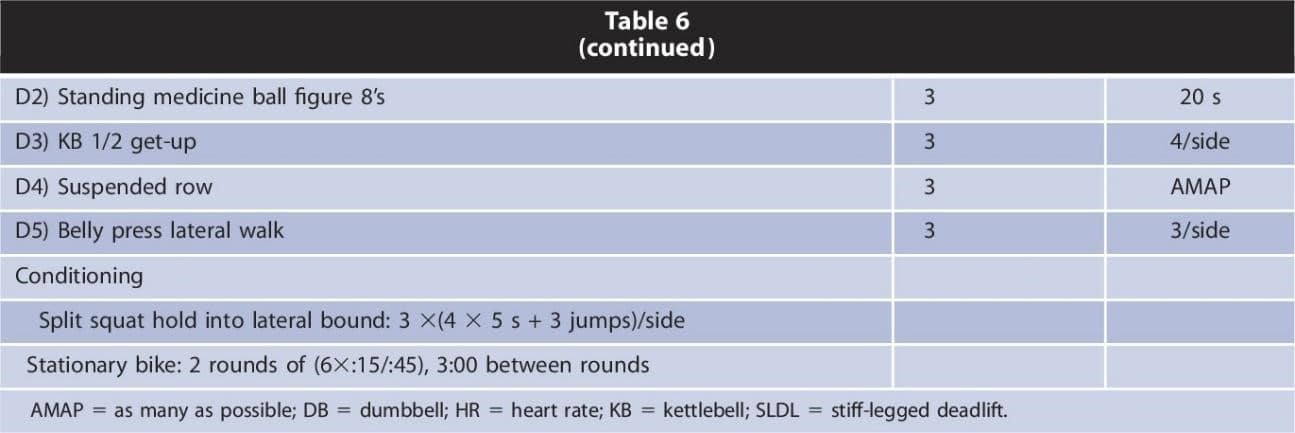
Sample in-Season Resistance Training for Hockey
Kevin Neeld also provides an example of in-season strength and conditioning training for hockey in his article ‘Preparing for the Demands of Professional Hockey,’ following the same structure explained in the previous section: five phases spanning a total of 14 weeks (Neeld, 2018). In this case, we present a list of exercises that showcase many new movements through which hockey players can improve their performance.
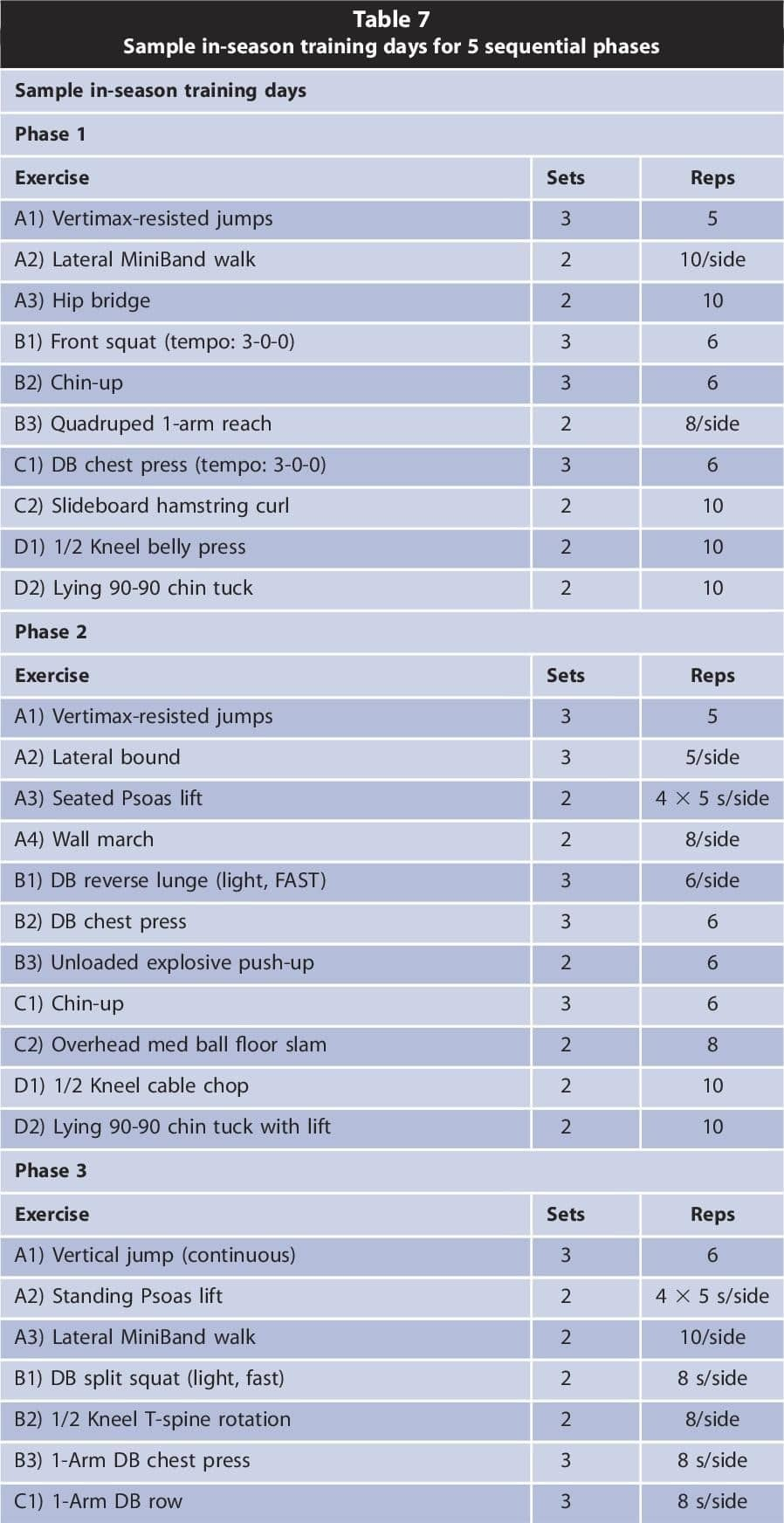
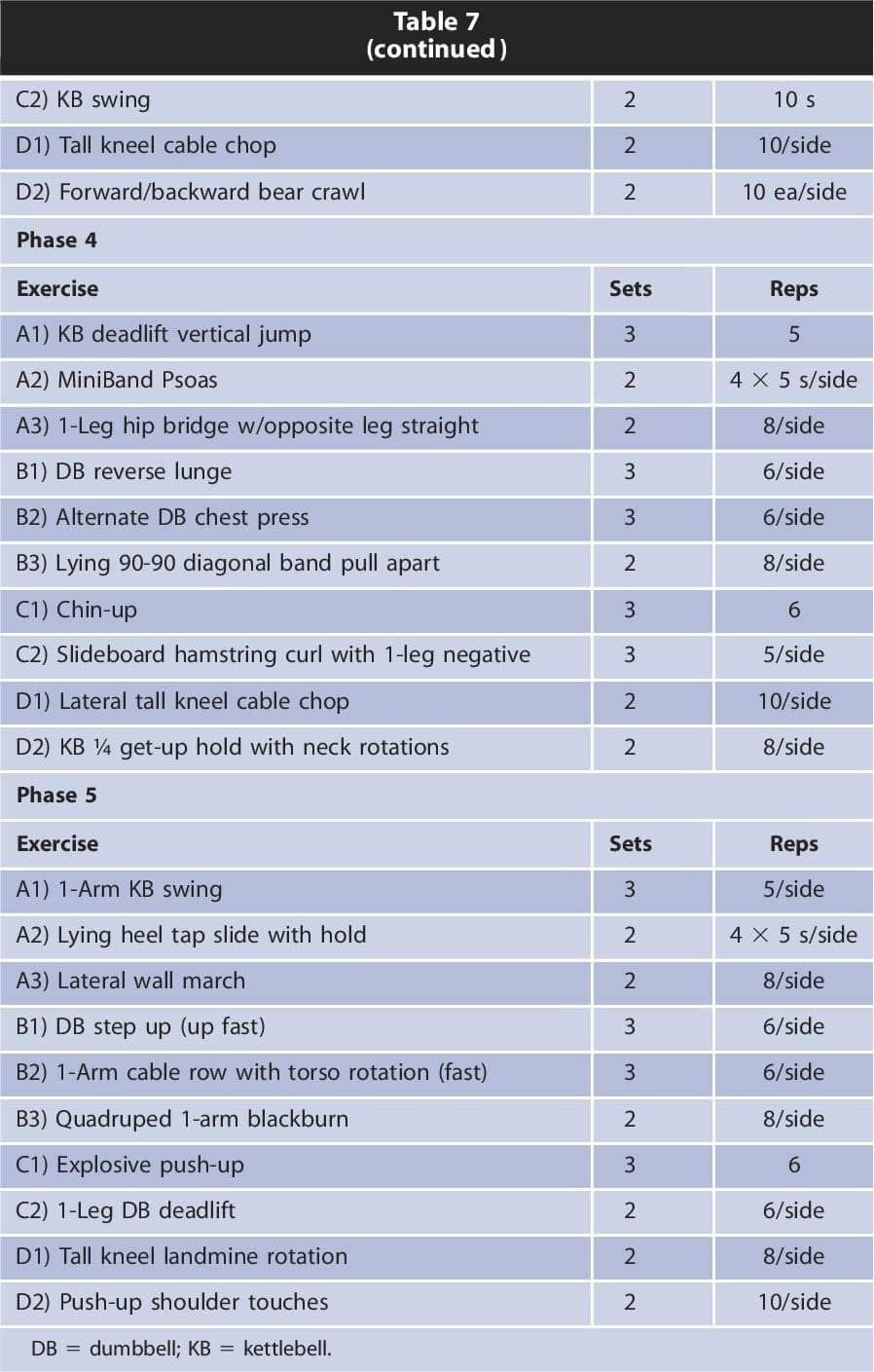
Joaquín Vico Plaza
References
Antunes, J. P., Oliveira, R., Reis, V. M., Romero, F., Moutão, J., & Brito, J. P. (2022). Comparison between Olympic Weightlifting Lifts and Derivatives for External Load and Fatigue Monitoring. Healthcare 2022, Vol. 10, Page 2499, 10(12), 2499. https://doi.org/10.3390/HEALTHCARE10122499
Buckeridge, E., LeVangie, M. C., Stetter, B., Nigg, S. R., & Nigg, B. M. (2015). An on-ice measurement approach to analyze the biomechanics of ice hockey skating. PloS One, 10(5). https://doi.org/10.1371/JOURNAL.PONE.0127324
Cahill, M. J., Cronin, J. B., Oliver, J. L., Clark, K. P., Lloyd, R. S., & Cross, M. R. (2019). Sled Pushing and Pulling to Enhance Speed Capability. Strength and Conditioning Journal, 41(4), 94–104. https://doi.org/10.1519/SSC.0000000000000460
Dæhlin, T. E., Haugen, O. C., Haugerud, S., Hollan, I., Raastad, T., & Rønnestad, B. R. (2017). Improvement of Ice Hockey Players’ On-Ice Sprint With Combined Plyometric and Strength Training. International Journal of Sports Physiology and Performance, 12(7), 893–900. https://doi.org/10.1123/IJSPP.2016-0262
Ebben, W. P., Carroll, R. M., & Simenz, C. J. (2004). Strength and conditioning practices of National Hockey League strength and conditioning coaches. Journal of Strength and Conditioning Research, 18(4), 889–897. https://doi.org/10.1519/14133.1
Neeld, K. (2018). Preparing for the demands of professional hockey. Strength and Conditioning Journal, 40(2), 1–16. https://doi.org/10.1519/SSC.0000000000000374
Nightingale, S. C. (2014). A strength and conditioning approach for ice hockey. Strength and Conditioning Journal, 36(6), 28–36. https://doi.org/10.1519/SSC.0000000000000107
Peterson, B. J., Fitzgerald, J. S., Dietz, C. C., Ziegler, K. S., Ingraham, S. J., Baker, S. E., & Snyder, E. M. (2015). Division I Hockey Players Generate More Power Than Division III Players During on- and Off-Ice Performance Tests. Journal of Strength and Conditioning Research, 29(5), 1191–1196. https://doi.org/10.1519/JSC.0000000000000754
Robbins, S. M., Renaud, P. J., MacInnis, N., & Pearsall, D. J. (2021). The relationship between trunk rotation and shot speed when performing ice hockey wrist shots. Journal of Sports Sciences, 39(9), 1001–1009. https://doi.org/10.1080/02640414.2020.1853336
Serrano, J., & Serrano, B. (2020). The Effect of Resisted Sprinting on the Production of Horizontal Strength – The Sport Journal. https://thesportjournal.org/article/the-effect-of-resisted-sprinting-on-the-production-of-horizontal-strength/
Singh, J., Appleby, B. B., & Lavender, A. P. (2018). Effect of Plyometric Training on Speed and Change of Direction Ability in Elite Field Hockey Players. Sports (Basel, Switzerland), 6(4). https://doi.org/10.3390/SPORTS6040144
Kenneth, C. (2019). NSCA. https://www.nsca.com/education/articles/nsca-coach/the-need-for-speedimproving-sprinting-performance-in-football-players/
Upjohn, T., Turcotte, R., Pearsall, D. J., & Loh, J. (2008). Three-dimensional kinematics of the lower limbs during forward ice hockey skating. Sports Biomechanics, 7(2), 206–221. https://doi.org/10.1080/14763140701841621

